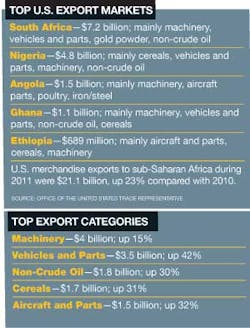Africa - A Bright Future Now
If Caterpillar Inc. (IW 500/21), considered a bellwether for the U.S. economy, is touting Africa's potential, then manufacturers need to take heed.
"I am more optimistic about Africa than I have ever been in my career," proclaimed Caterpillar CEO Doug Oberhelman on May 4, 2012, during an event at Baroloworld, its distributor in South Africa.
See Also: Manufacturing Plant Site Location Strategies
At the event, Oberhelman mentioned a joint venture the company has in Nigeria. "As Africa develops and policy changes and living standards rise, the demand for equipment will also rise," he told reporters.
As far as locating a plant in Africa, Oberhelman said his company will have a facility there in the future, but that it's more than a couple of years out at this point.
What Oberhelman sees is what the rest of the manufacturing world is beginning to see as well. The strongest case the continent presents is its GDP growth. Africa is home to six out of the top 10 countries that are experiencing economic growth, according to an analysis by the Economist. Over the past decade, it has been the second-fasting growing region in the world, averaging growth of 5.1% during that period.
New Home for American Exports?
In 2012, Africa was expected to grow at a rate of 5% to 5.7%, according to the International Monetary Fund.
But while that easily outdistances rates in sluggish Western Europe and the United States, faster growth may be ahead. The World Bank is almost giddy in its prediction that "Africa could be on the brink of an economic take-off much like China was 30 years ago and India 20 years ago."
Such predictions are prompting an active pursuit of investment in Africa by U.S. firms. In February of this year, Anadarko Petroleum, Caterpillar, Chevron, Energy International and General Electric were part of a State Department-led energy trade mission to Mozambique, Tanzania, Nigeria and Ghana.
"The United States is ready to do business in Africa in a much bigger way," Deputy Assistant Secretary of State for African Affairs William Fitzgerald said during that visit. He encouraged both U.S. and international firms to invest in sustainable development across Africa.
A leading Senate Democrat agrees. Illinois Sen. Dick Durbin introduced S.B. 2215,"Increasing American Jobs Through Greater Exports to Africa Act of 2012." The bill notes that "countries in Africa have a collective spending power of almost $9 billion and a gross domestic product of $1.6 trillion, which are projected to double in the next 10 years." The bill is designed to bolster U.S. aid for companies investing in Africa, particularly through the Export-Import Bank, with the objective of increasing exports of U.S. goods and services to Africa by 200% in real dollar value within 10 years, as well as improving the competitiveness of U.S. businesses in Africa.
Paving the way for an increase in exports is the rising level of disposable income by the 40% of the population that now lives in cities. By 2030 that number will rise to 50%, with Africa's top cities having a combined spending power of $1.3 trillion, according to a recent study by McKinsey.
The study also showed that most African households spend 30% of their income on groceries, 10% on clothing and 6% on telecommunications.
That could account for why behemoth retailer Wal-Mart has invested $2.4 billion in Africa. "There are a lot of things to be optimistic about in the region," said Doug McMillon, Wal-Mart International president and CEO.
Many companies are already exporting to Africa, especially in the more well-established countries such as South Africa. The United States exported more than $7 billion to South Africa in 2011, a 30% increase from the previous year. "We've heard the number 600 representing the American businesses that have put down roots in this country, but that is growing and we encourage that growth," the State Department's Fitzgerald said.
In addition to viewing Africa as a new export market, many companies are seeing Africa as a place to grow the bottom line by establishing plants to service the continent. Ford, which has had a long-time presence in Africa (since 1923 in South Africa) is benefitting from the growth and just announced in August that it was adding 800 new jobs at two plants in South Africa to keep up with growing demand.
GE (IW 500/5) currently has projects in Nigeria, Kenya, South Africa, Angola and Ghana. In March of this year, GE signed a deal to build $10 billion worth of power plants in Nigeria over the next decade.
Cummins Power Generation is also exporting products to Africa, as evidenced by its sale of generator sets to provide power for Telecel, the second-largest mobile-phone network in Zimbabwe.
In the cotton market in Zambia, three U.S. companies have investments. Cargill Cotton Ginners Limited, which has been active in the country since 2006, has investments worth over $18 million. Dunavant Cotton's investments total $25 million, while the National Milling Corp. has invested more than $20 million.
The food industry is targeting Africa for expansion as well. In August, Nestle opened its first facility in Angola. It will serve as a finishing center for milk powder. "Angola is not only one of the fastest-growing economies in Africa, but one of the fastest-growing in the world, with a rising middle class," said Nestle CEO Paul Bulcke at the plant opening.
Setting Up Shop in Africa
GE carefully chooses its investments in Africa. While a McKinsey study proclaims that the rate of return on foreign investment is higher in Africa than any other developing region, GE isn't so sure. "You have supposedly got a lot of money that's available for African investment, but there is this gap between what's bankable and what's not," said Jay Ireland, CEO of GE Africa.
While Caterpillar, Ford and GE represent U.S. companies that are heavily invested in Africa, other American companies are slower to put down roots. "The U.S. is behind other parts of the world when it comes to investing in Africa," said Tim Hanley, global leader of Deloitte's Manufacturing Industry Group.
Part of the reason, says Hanley, is the infrastructure, which makes it very difficult to conduct business both within and across the 54 countries. Efforts are underway to improve ports, rails and roads, Hanley points out.
Energy is another issue, says Hanley, citing a World Bank study that says manufacturing enterprises experience outages every 56 days on average. The World Bank says this insufficient energy grid results in companies losing 6% of sales, and if a backup generator isn't available, the loss could be as much as 20%.
Even when energy is available, the cost is steep. "It is hard to compete for foreign direct investment if your energy costs 30 cents per kWh while you could have it at 5 cents in another developing country," World Bank Vice President Makhtar Diop commented in October after the Africa CEO Summit in Tokyo, Japan.
These factors might account for the "unevenly distributed investments with a large share of FDI going to extractive industries in a limited group of countries," Hanley says.
The continent is working on improving the business environment. For example, the IFC/World Bank report "Doing Business 2012" indicates that 36 of 46 governments in Sub-Saharan Africa improved their economy's regulatory environment for commerce in 2010 and 2011.
Another challenge, not unique to Africa, is the availability of a skilled workforce. The current workforce of 382 million (which will grow another 122 million by 2010) is becoming more educated. Forty percent of Africans have some secondary or tertiary education. However, employers from South Africa reported in a McKinsey survey that they are having problems finding workers with specific skills.
These higher-level skills will be especially important in the manufacturing sector, which is projected to create 8 million jobs by 2020 with current policies and could add 7 million more jobs if reforms are enacted, McKinsey says. Even though the sector will create jobs in the future, manufacturing in Africa, like much of the world, has declined recently. In 27 major African economies, the GDP share from manufacturing fell from 15% in 2000 to 12% in 2012.
Sectors of Growth
Despite these many challenges, Hanley notes that companies are keeping an eye on the opportunities. "The automotive sector is perhaps the most established sector, but there are also increasing investments in the metals and mining, aerospace and defense, chemicals, and other industrial manufacturing sectors."
BASF, for example, recenFrancisco Sanchez, undersecretary for International Trade at the Treasury Department, has identified other specific sectors for investment. As the government of South Africa is aiming to double its energy-production capacity over the next 20 years with 40% coming from renewable energy, opportunities abound.
Sanchez points out in recent testimony that "the rapidly growing economies of Sub-Saharan Africa are driving demand for power. Due to the poor state of electrical infrastructure, plans for massive investments are occurring throughout the region. Opportunities exist in solar, wind, hydro, biomass and clean-coal-generation technologies, power transmission and a wide range of energy-efficient technologies."
Sanchez also identified aviation as a growth sector as airlines are upgrading and expanding. "Militaries in South Africa, Nigeria and elsewhere are considering purchases of airlift, maritime patrol, surveillance aircraft and other assets primarily for peacekeeping, humanitarian relief, anti piracy and border-patrol missions," he noted.
Shape of Things to Come
While the challenges of infrastructure, workforce and general business issues are formidable in Africa, Jeffrey Immelt, CEO of GE, feels the "time is now" to invest in Africa.
"Companies really want to invest in Africa right now," Immelt said during a speech he gave on Jan. 30 at the Stanford Institute for Economic Policy Research Summit 2012. "It's very much top of mind. I think the next two decades are going to offer tremendous opportunities for East Africa and Sub-Saharan Africa."
While he sees the opportunities, he acknowledged that "there is always risk and volatility." However, GE is a long-term investor, he said. "When we feel the rule of law, good government and stability is under way, that can accelerate growth even further."
Immelt was very enthusiastic about growth potential. "I see many trends that are under way. For a guy like me that has been doing this 30 years, it is exciting. We picked up the evolution of China and Brazil and many other regions and the time is now [for Africa], not 20 years from now."

